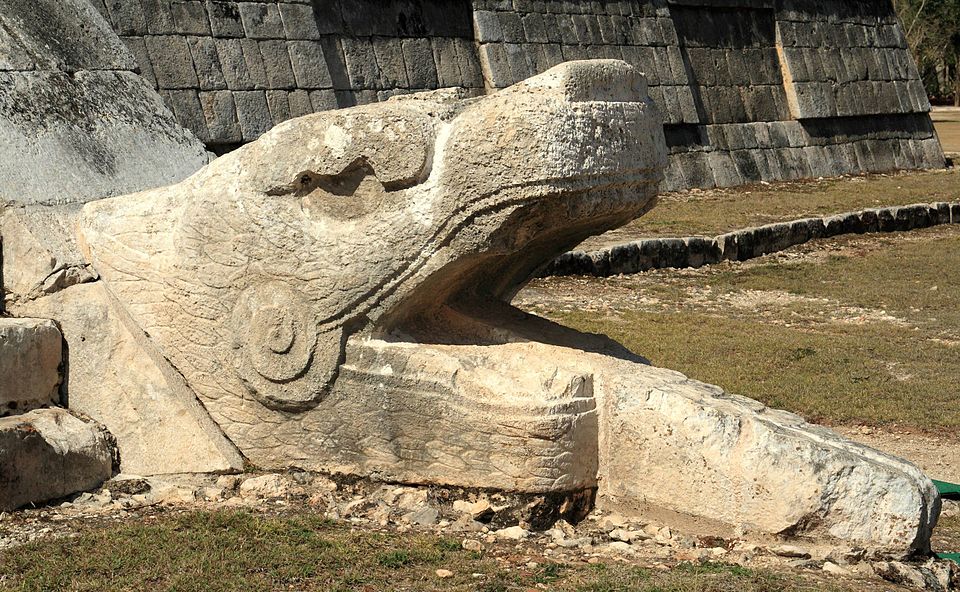Kukulkán (KOO-kool-kahn)
Feathered Serpent
Through mountain air veined with sunlight and silence, the Kukulkán coils like a living breeze. Its feathers shimmer with a palette of emerald and flame, refracting light in hues that seem pulled from the Realm’s own breath. Where it moves, the canopy stills—not out of fear, but awe. Leaves tilt toward its wake, and the wind hushes to listen. It is less a beast than a current made visible.
Unlike the terrestrial serpents of old myths, the Kukulkán of Tír na nÓg does not cling to the ground, nor does it dominate the skies. It drifts between, moving as both echo and omen, its flight neither direct nor wasteful. Each motion is a gesture of choice, of purpose. In the deep valleys and at the edge of cliffside ruins, sapient observers have stood breathless at its passing, unsure if they witnessed a migration or a miracle.
When it glides above the sacred cenotes or through the thermal updrafts of emerald canyons, its plumage trails refracted halos, each plume tipped in the firelight of intention. It does not circle prey; it orbits meaning. A flash of iridescent scales may mark a courtship dance—or the answer to a whispered prayer.
Even now, some say it appears only when the wind itself must change. From temple ledges and crumbling staircases, sentinels still carve its likeness, not in fear or worship, but remembrance. Not of a god—but of the rhythm that once taught people to move gently, in rhythm with the world they built from sky, stone, and silence.
In The Mortal Realm, Kukulkán (and its Nahuatl counterpart Quetzalcóatl) is revered as a deity of wind, learning, and renewal. Serpent-bodied and feathered, this divine figure walks between worlds, shaping the rise of civilizations and ushering in cycles of rebirth. In Tír na nÓg, this mythic lineage is not carried forward as divinity, but as resonance. The Kukulkán of the Realm is not worshipped, but remembered—its presence linked to transitional times, whispered decisions, and the weightless pause between breath and purpose.
Behavior & Communication
Kukulkán are primarily solitary creatures, but during mating seasons or rare celestial alignments, they become strikingly social. During these periods, multiple individuals perform synchronized aerial displays that resemble luminous, feathered constellations in motion. These dances are not aggressive or territorial but serve as displays of mutual recognition and courtship, often occurring above ley-rich highlands or along steep cliffside corridors. They communicate via finely tuned vibrations channeled through feather shafts and musculature, producing inaudible frequencies that resonate through the air. These pulses are not linguistic but emotive, conveying alignment, presence, or intention. Observers describe an uncanny feeling of "being seen" when a Kukulkán is near, though the creature itself often remains just out of sight. Inter-species interactions are minimal, though Kukulkán have been observed shadowing small flocks or gliding alongside glimmerbeasts in what appears to be silent companionship. When encountered alone, they tend to drift slowly, responding only to shifts in air pressure or emotional current. They do not flee, but they also do not linger.Ecological Niche
Kukulkán prefer the high thermal ridgelines, open skies, and humid updraft zones of Tír na nÓg's cliff forests and sacred summits. They are attuned to geoaetheric winds—currents charged with both temperature and spiritual tension—and their presence can often be traced by subtle shifts in the migratory patterns of birds, insects, and cloud structures. Rather than preying upon fauna, Kukulkán feed indirectly through a process of atmospheric osmosis, absorbing trace nutrients from wind-carried spores, flower pollen, and bioluminescent plankton rising from sacred pools. Their passage through an area correlates with improved air clarity, stabilized wind behavior, and more synchronized blooming of wind-pollinated plants. Their preferred nesting zones are carved out naturally within cliff hollows inaccessible to most predators, usually aligned with seasonal air corridors. These sites often accumulate seeds and spores from across vast distances, unintentionally transforming Kukulkán roosts into fertile aerial gardens.Common Myths & Legends
Mesoamerican Traditions – Yucatec & MexicaIn The Mortal Realm, Kukulkán (and its Nahuatl counterpart Quetzalcóatl) is revered as a deity of wind, learning, and renewal. Serpent-bodied and feathered, this divine figure walks between worlds, shaping the rise of civilizations and ushering in cycles of rebirth. In Tír na nÓg, this mythic lineage is not carried forward as divinity, but as resonance. The Kukulkán of the Realm is not worshipped, but remembered—its presence linked to transitional times, whispered decisions, and the weightless pause between breath and purpose.
| APPEARANCE/PHENOTYPE |
|---|
| Avian-serpentine hybrid. The body is long and serpentine with fine vertebral musculature, covered in iridescent scales of jade, sapphire, and gold. Feather coverage is most prominent along the dorsal ridge and tail. Display feathers form elaborate plumes along the head, spine, and tail, shifting in color with both wind pressure and aetheric emotion. Eyes are almond-shaped with vertical pupils and gold-ringed sclera. Wings are modified feather-fans that fold against the flanks when not in motion, providing minimal resistance. |
height |
length |
weight |
|---|---|---|
39.9 cm |
299.52 cm |
25.00 kg |
Genetic Ancestor(s)
Scientific Name
Ainmhí; Réamhach; Mesomericanus kukulkán
Origin/Ancestry
Once worshipped as a deity of the wind and waves, now a revered creature of the island's skies and forests.


















